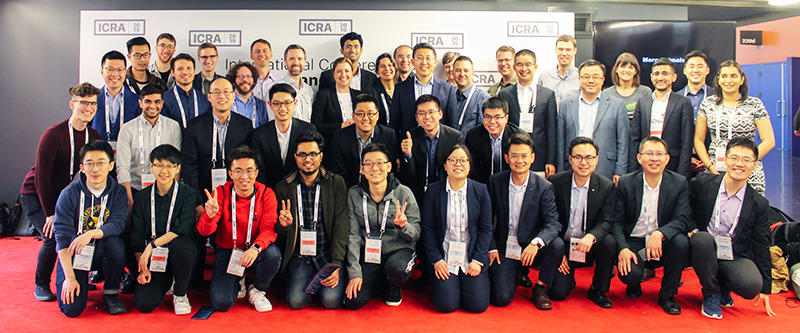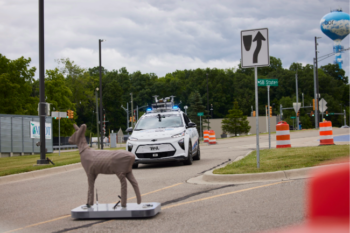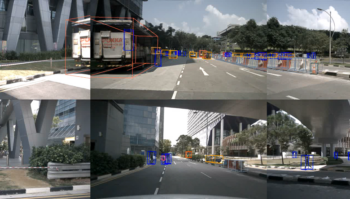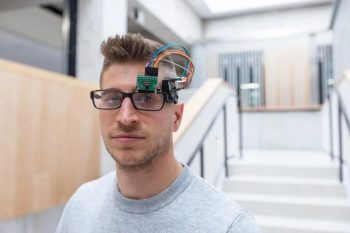The new University of Toronto Robotics Institute, created in April 2019, establishes a central headquarters for world-leading robotics research across U of T and beyond.
“We’re highly driven and want to make impact right out of the gate,” says its inaugural director, Professor Yu Sun (MIE).
Last week, Sun and nine Robotics Institute faculty members, along with more than 30 graduate students, attended the 2019 IEEE International Conference on Robotics and Automation (ICRA) in Montreal, Que., one of the most prestigious venues for global robotics research. The event was a prime opportunity to raise the profile of U of T Engineering robotics research on the international stage.
“We had a coordinated presence at the conference that was absolutely noticed,” says Sun. “Our booth was busy the whole time, with students and faculty from other institutions and industry asking about our research program. The message that our international peers took home was, ‘the U of T Robotics Institute has a top-quality research team.’”

The Robotics Institute strengthens cohesion and knowledge sharing by facilitating collaborative robotics research both across the University and with outside partners.
“This level of collaboration will have a tremendous positive impact on the quality of both our research and the educational experience we provide to our students,” says Sun.
Over the next six months, Sun and the Robotics Institute team plan to introduce university-wide workshops and regular seminars. They will also elevate the Institute’s home base, the two-storey Norris Walker 5T7 Robotics Laboratory, located in the Myhal Centre for Engineering Innovation & Entrepreneurship. The flexible facility was completed last year and is already home to a wide range of equipment, as well as many different types of robots.
“The Robotics Institute further strengthens our world class, leading research and educational initiatives in a continuously developing sector,” says Dean Cristina Amon. “With our state-of-the-art facilities in the new Myhal Centre for Engineering Innovation & Entrepreneurship, as well as support from our Dean’s Strategic Fund, the Institute catalyzes multidisciplinary collaborations between faculty, students, alumni and external partners.”
“The Robotics Institute will serve as the central headquarters that unites robotics research and education from across the University,” adds Sun. “The Myhal Centre was thoughtfully designed from its inception to enable interdisciplinary collaboration. This makes it a perfect fit for a collaborative field like robotics.”
On June 25, the Robotics Institute hosts a celebration in the Myhal Centre to unite faculty, graduate student researchers and industry partners, in recognition of its official launch.
In addition to facilitating collaborations, providing a central hub will bring greater international visibility to the strong robotics research groups that already exist across the University.
“Our various research clusters each have different space and location requirements, and so they are spread out across three campuses. In the past, this has made it challenging for industry to find us,” says Sun.
“We increasingly have international delegations asking to visit our robotics facilities. With our new central headquarters, we now have a concrete meeting point for introducing visitors to the breadth and depth of robotics research we undertake as Canada’s major comprehensive university. This will lead to higher impact, industry and academic partnerships, and ensure the sustainability and success of the institute over the long run,” he says.
Three research pillars will help drive the Robotics Institute’s collaboration and impact:
Autonomous field robotics
This pillar will be led by Professor Tim Barfoot (UTIAS), a renowned expert on self-driving vehicles and drones. Faculty members includes UTIAS professors Steven Waslander, Angela Schoellig and Jonathan Kelly, to name a few.
“We have fantastic people. They’re all internationally known and their work is synergistic,” says Sun.
Barfoot is currently working with Schoellig on several projects. One is a collaboration with Drone Delivery Canada on a system to enable UAVs to navigate using visual signals rather than data from GPS satellites. They’ve demonstrated the method in field trials at Canadian Forces Bases in Suffield and Montreal.
They are also advisors for aUToronto, U of T Engineering’s entry in the AutoDrive Challenge™. The team came out on top at the first competition in the three-year challenge and hope to repeat their success this week. “We’re aggressively preparing for year two,” says Barfoot. “I’m blown away by the sophistication of this team and can’t wait to see what comes next.”
Health care robotics
This pillar will be led by Sun, who holds the Canada Research Chair in Micro and Nanoengineering Systems. Researchers in this pillar include professors such as Goldie Nejat (MIE), Eric Diller (MIE), James Drake (IBBME), to name a few.
“This pillar also has significant strength; we have an extraordinary core of researchers focused on human health and health care,” says Sun.
For Sun and his graduate students, they will continue advancing robots with the ability to sense and manipulate cells for surgeries at the cellular level. Most recently, he and his team built a set of magnetic ‘tweezers’ that can position a nano-scale bead inside a human cell in three dimensions with unprecedented precision. The nano-bot has been used to study the inside properties of cancer cells, and could point the way toward enhanced diagnosis and treatment.
This pillar is enhanced by a recently awarded NSERC CREATE grant, which is connecting the health-care roboticists more strongly for close collaborations.
Manufacturing robotics
Led by Professor Hani Naguib (MIE), this pillar will be of significant focus for the institute moving forward.
“We realize how important advanced manufacturing is to the economic growth of Ontario and Canada. Although we have world-class researchers working in manufacturing, there is a crucial need to bolster this pillar, in terms of robotics for manufacturing,” says Sun.
Naguib is the director of the Toronto Institute for Advanced Manufacturing (TIAM), and has been a key figure in advanced manufacturing on the national and world stage. In February 2018, Canada’s new Innovation Supercluster in Advanced Manufacturing was announced, of which includes contributions from Naguib and TIAM.
As the lead of the advanced manufacturing pillar, Naguib and his colleagues will develop the next generation of manufacturing robots.
“Robots have always been part of the manufacturing industry,” says Naguib. “Our task is to make the interaction between robots an humans that work alongside them more seamless.”
Sun realizes the Robotics Institute’s ambitions are lofty but is confident of its future impact, especially after the tremendous positive feedback the members received by the robotics community at ICRA.
“We built a lot of excitement there. The whole world now knows of our U of T’s roboticist team. We will keep the momentum going between now and the launch, and beyond,” says Sun.



